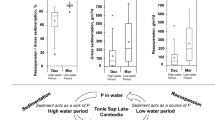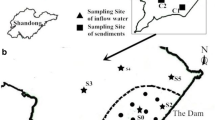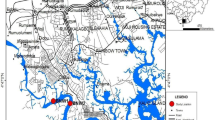Abstract
Purpose
Although hypolimnetic anoxia is a common occurrence in deep lakes and reservoirs, understanding the processes of oxygen depletion in water columns and sediment is challenging. This study investigates oxygen depletion in both the hypolimnion and sediments in a stratified reservoir. The areal hypolimnetic oxygen demand (AHOD) and sediment oxygen demand (SOD) were evaluated to determine key factors of hypolimnetic anoxia.
Materials and methods
To evaluate the characteristics of the AHOD in the Jinpen Reservoir (JPR), China, 4 years of field observations of dissolved oxygen (DO) and temperature datasets in the water column are analyzed. SOD was calculated as the sum of the sediment oxygen uptake (\({\text{J}}_{{\text{O}}_{2}}\)) and the flux of reduced substances from deeper sediment layers into the overlying water (Fred), where \({\text{J}}_{{\text{O}}_{2}}\) was obtained from DO profiles across the sediment–water interface (SWI) at a depth of approximately 94 m in the reservoir, and Fred was obtained from sediment cores.
Results
The AHOD in the JPR varied from 0.299 to 1.451 g m−2 day−1 during the summer stratification between 2014 and 2017. The SOD, containing \({\text{J}}_{{\text{O}}_{2}}\) and Fred, decreased from 0.534 to 0.386 g m−2 day−1 during stratification. Within the SOD, \({\text{J}}_{{\text{O}}_{2}}\) decreased from 0.415 to 0.168 g m−2 day−1, whereas Fred increased from 0.119 to 0.218 g m−2 day−1.
Conclusion
The increase in primary productivity (e.g., diatom blooms), inflows during rainfall, and oxygen concentrations can significantly increase AHOD. The relative importance of \({\text{J}}_{{\text{O}}_{2}}\) at 40–70% of the SOD is high in the JPR; thus, oxic respiration of organic carbon is the dominant pathway of DO consumption.







Similar content being viewed by others
References
Akomeah E, Lindenschmidt KE (2017) Seasonal variation in sediment oxygen demand in a northern chained river-lake system. Water 9(4):254-267
Arega F, Lee JHW (2005) Diffusional mass transfer at sediment–water interface of cylindrical sediment oxygen demand chamber. J Environ Eng 131(5):755–766
Beutel M, Dent S, Reed B, Marshall P, Gebremariam S, Moore B, Cross B, Gantzer P, Shallenberger E (2014) Effects of hypolimnetic oxygen addition on mercury bioaccumulation in Twin Lakes, Washington, USA. Sci Total Environ 496:688–700
Beutel M, Hannoun I, Pasek J, Bowman Kavanagh K (2007) Evaluation of hypolimnetic oxygen demand in a large eutrophic raw water reservoir, San Vicente Reservoir. California J Environ Eng 133(2):130–138
Beutel MW (2003) Hypolimnetic anoxia and sediment oxygen demand in California drinking water reservoirs. Lake Reserv Manage 19(3):208–221
Beutel MW, Horne AJ (1999) A review of the effects of hypolimnetic oxygenation on lake and reservoir water quality. Lake Reserv Manage 15(4):285–297
Bierlein KA, Rezvani M, Socolofsky SA, Bryant LD, Wüest A, Little JC (2017) Increased sediment oxygen flux in lakes and reservoirs: the impact of hypolimnetic oxygenation. Water Resour Res 53(6):4876–4890
Bryant LD, Gantzer PA, Little JC (2011a) Increased sediment oxygen uptake caused by oxygenation-induced hypolimnetic mixing. Water Res 45(12):3692–3703
Bryant LD, Hsu-Kim H, Gantzer PA, Little JC (2011b) Solving the problem at the source: controlling Mn release at the sediment–water interface via hypolimnetic oxygenation. Water Res 45(19):6381–6392
Bryant LD, Lorrai C, McGinnis DF, Brand A, Wüest A, Little JC (2010a) Variable sediment oxygen uptake in response to dynamic forcing. Limnol Oceanogr 55(2):950–964
Bryant LD, McGinnis DF, Lorrai C, Brand A, Little JC, Wüest A (2010b) Evaluating oxygen fluxes using microprofiles from both sides of the sediment–water interface. Limnol Oceanogr-Meth 8(11):610–627
Butler BA (2011) Effect of imposed anaerobic conditions on metals release from acid-mine drainage contaminated streambed sediments. Water Res 45(1):328–336
Cornett J, Rigler F (1979) Hypolinimetic oxygen deficits: their prediction and interpretation. Science 205:580–581
Dedieu K, Rabouille C, Thouzeau G, Jean F, Chauvaud L, Clavier J, Mesnage V, Ogier S (2007) Benthic O2 distribution and dynamics in a Mediterranean lagoon (Thau, France): an in situ microelectrode study. Estuar Coast Shelf S 72(3):393–405
Ding S, Han C, Wang Y, Yao L, Wang Y, Xu D, Sun Q, Williams PN, Zhang C (2015) In situ, high-resolution imaging of labile phosphorus in sediments of a large eutrophic lake. Water Res 74:100–109
Fink G, Wessels M, Wüest A (2016) Flood frequency matters: why climate change degrades deep-water quality of peri-alpine lakes. J Hydrol 540:457–468
Friedrich J, Janssen F, Aleynik D, Bange H, Boltacheva N, Çağatay MN, Dale A, Etiope G, Erdem Z, Geraga M, Gilli A, Gomoiu MT, Hall P, Hanson D, He Y, Holtappels M, Kirf M, Kononets M, Konovalov S, Wenzhoefer F (2014) Investigating hypoxia in aquatic environments: diverse approaches to addressing a complex phenomenon. Biogeosciences 10:12655–12772
Gantzer PA, Bryant LD, Little JC (2009a) Controlling soluble iron and manganese in a water-supply reservoir using hypolimnetic oxygenation. Water Res 43(5):1285–1294
Gantzer PA, Bryant LD, Little JC (2009b) Effect of hypolimnetic oxygenation on oxygen depletion rates in two water-supply reservoirs. Water Res 43(6):1700–1710
Granina L, Müller B, Wehrli B (2004) Origin and dynamics of Fe and Mn sedimentary layers in Lake Baikal. Chem Geol 205(1–2):55–72
Huang TL, Li X, Rijnaarts H, Grotenhuis T, Ma WX, Sun X, Xu JL (2014) Effects of storm runoff on the thermal regime and water quality of a deep, stratified reservoir in a temperate monsoon zone, in Northwest China. Sci Total Environ 485–486:820–827
Huisman J, Weissing FJ (1995) Competition for nutrients and light in a mixed water column: a theoretical analysis. Am Nat 146(4):536–564
Kristiansen KD, Kristensen E, Jensen EMH (2002) The influence of water column hypoxia on the behaviour of manganese and iron in sandy coastal marine sediment. Estuar Coast Shelf S 55(4):645–654
Li N, Huang TL, Chang ZZ, Li K (2021) Effects of benthic hydraulics on sediment oxygen demand in a canyon-shaped deep drinking water reservoir: experimental and modeling study. J Environ Sci 102:226–234
Li N, Huang TL, Li Y, Si F, Zhang HH, Wen G (2020) Inducing an extended naturally complete mixing period in a stratified reservoir via artificial destratification. Sci Total Environ 745:140958
Li N, Huang TL, Mao XJ, Zhang HH, Li K, Wen G, Lv XL, Deng LF (2019) Controlling reduced iron and manganese in a drinking water reservoir by hypolimnetic aeration and artificial destratification. Sci Total Environ 685:497–507
Livingstone DM, Imboden DM (1996) The prediction of hypolimnetic oxygen profiles: a plea for a deductive approach. Can J of Fish Aquat Sci 53(3):924–932
Ma WX, Huang TL, Li X, Zhou ZZ, Li Y, Zeng K (2015) The effects of storm runoff on water quality and the coping strategy of a deep canyon-shaped source water reservoir in China. Int J Environ Res Pub He 12(7):7839–7855
Matthews D, Effler S (2006) Long-term changes in the areal hypolimnetic oxygen deficit (AHOD) of Onondaga Lake: evidence of sediment feedback. Limnol Oceanogr 51:702–714
Matzinger A, Müller B, Niederhauser P, Schmid M, Wüest A (2010) Hypolimnetic oxygen consumption by sediment-based reduced substances in former eutrophic lakes. Limnol Oceanogr 55(5):2073–2084
Müller B, Bryant LD, Matzinger A, Wuest A (2012) Hypolimnetic oxygen depletion in eutrophic lakes. Environ Sci Technol 46(18):9964–9971
Nakamura Y, Satoh H, Okabe S, Watanabe Y (2004) Photosynthesis in sediments determined at high spatial resolution by the use of microelectrodes. Water Res 38(9):2439–2447
Rhodes J, Hetzenauer H, Frassl MA, Rothhaupt KO, Rinke K (2017) Long-term development of hypolimnetic oxygen depletion rates in the large Lake Constance. Ambio 46(5):554–565
Rong N, Shan B (2016) Total, chemical, and biological oxygen consumption of the sediments in the Ziya River watershed. China Environ Sci Pollut Res Int 23(13):13438–13447
Rong N, Shan B, Wang C (2016) Determination of sediment oxygen demand in the Ziya River Watershed, China: based on laboratory core incubation and microelectrode measurements. Int J Environ Res Pub He 13(2):232
Schwefel R, Hondzo M, Wüest A, Bouffard D (2017) Scaling oxygen microprofiles at the sediment interface of deep stratified waters. Geophys Res Lett 44(3):1340–1349
Schwefel R, Steinsberger T, Bouffard D, Bryant LD, Müller B, Wüest A (2018) Using small-scale measurements to estimate hypolimnetic oxygen depletion in a deep lake. Limnol Oceanogr 63(S1):S54–S67
Visser PM, Ibelings BW, Bormans M, Huisman J (2015) Artificial mixing to control cyanobacterial blooms: a review. Aquat Ecol 50(3):423–441
Wu R, Zhou B, Randall D, Woo N, Lam P (2003) Aquatic hypoxia is an endocrine disruptor and impairs fish reproduction. Environ Sci Technol 37:1137–1141
Zhou CY, Guan DX, Williams PN, Luo J, Ma LQ (2016) Novel DGT method with tri-metal oxide adsorbent for in situ spatiotemporal flux measurement of fluoride in waters and sediments. Water Res 99:200–208
Funding
The authors received financial support from the National Natural Science Foundation of China (Grant No. 51979217) and the Shaanxi Provincial Key Research and Development Program (Grant No. 2018ZDXM-SF-029, 2019ZDLSF06-01 and 2019ZDLSF06-02).
Author information
Authors and Affiliations
Corresponding author
Additional information
Responsible editor: Haihan Zhang
Publisher's Note
Springer Nature remains neutral with regard to jurisdictional claims in published maps and institutional affiliations.
Supplementary Information
Below is the link to the electronic supplementary material.
Rights and permissions
About this article
Cite this article
Li, N., Yang, B., Huang, T. et al. Hypolimnetic anoxia and sediment oxygen demand during stratification in a drinking water reservoir. J Soils Sediments 21, 3380–3391 (2021). https://doi.org/10.1007/s11368-021-02976-1
Received:
Accepted:
Published:
Issue Date:
DOI: https://doi.org/10.1007/s11368-021-02976-1




